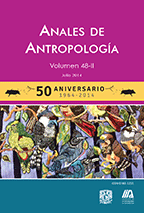Mexican archaeology in tour guides: hobby and education
Main Article Content
Abstract
Guidebooks have been criticized for their apparent simplicity, for focusing on the typical and exotic, and for reproducing stereotypes. But besides being a means to promote tourism, guidebooks are cultural products within a specific ideology and a means to create particular narratives. In this paper, we argue that since the establishment of the inah, in the late 1930s, archaeological tourism has been promoted from an educational perspective mainly for a domestic audience. Educational tourism has been an essential feature of the Mexican government policy and remains so today. Furthermore, since 1970, the increase in mobility and new forms of entertainment led to archaeological sites be offered as a hobby; archaeological
tourism nowadays is a source of foreign currency. The central idea of this paper is to demonstrate that a guidebook is not an isolated, naive or simple cultural product, but a reflection of the political, ideological and economic contexts. It is therefore proposed that rather than being only a tourist’s instructions, they might also be considered as a way to reproduce and maintain diverse narratives about the past.
Downloads
Article Details
Citas en Dimensions Service
Esta revista usa una licencia CC del tipo CC BY-NC-ND 3.0. Se maneja bajo el esquema de acceso abierto, con una licencia Creative Commons Attribution-NonCommercial-NoDerivs 3.0 Unported.
